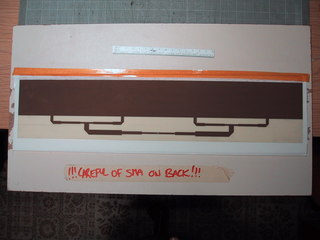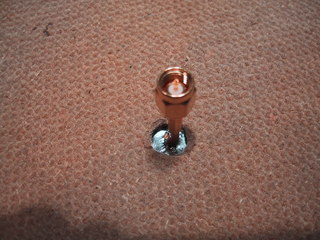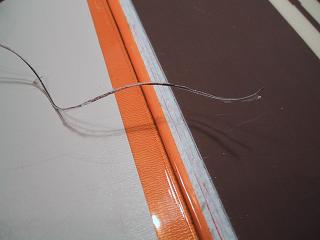Who: Glenn, Andrew, Tim, and Tom Scott and whoever
To do: Glenn, add details. Tim, add details and numbers, and add the formula discussion to the end, or at least link it in to this page.
The night before, Glenn and Andrew put together a "flat" cylindrical patch antenna: instead of making the CPA on a cylindrical molde (i.e. a pirece of airframe tubing), we just made it on a piece of flat fiber board. That way we could check a few things:
- It would tell us if there was any difference between a cylindrical or flat antenna: we hypothesized that they should be very close.
- If the flat antenna was close to the already built cylindrical one, then we'd know that our process was robust (for n=2 anyway ;) ) and process variations weren't a big deal.
- A flat antenna is much easier to accurately trim.
We met down in the PSU Microwave Lab at 10:00am and Phillip let us in and tried to act patient with us as we made noise and disturbed the test equipment. Thanks Phillip, we do appreciate it.
Glenn cal'd the HP 8753E Vector Network Analyzer (VNA) while Tom and Andrew yakked.
Our first results on the VNA showed that we were right on counts 1-2: the flat antenna was very close to the cylinder. Whew. The original antenna had a resonant frequency of 2.293 GHz with a VSWR of 1:1.05, whereas the flat new one had 2.298 GHz with a VSWR of 1:1.10.
Flat CPA with no modifications: SCRN00,01
We then started trimming down the patch which proved our 3rd point: it was pretty easy. First, we chopped off the fiberglass from above the copper patch, and that seemed to make no difference (as we had hoped). The measured resonant frequency shifted to 2.297GHz while the SWR was unchanged. We then proceeded to forget to save the screen shot from that test, but there really seemed to be no difference.
Based on the 2.4 GHz patch's actual resonant frequency of 2.29GHz, we calculated the "corrected" dielectric constant (Er) = 1.246. Using this value, we found that about a 3mm change in antenna should correct the resonance of the patch. To try and get the slope of the line, we took off ~ 1mm of material:
~ 1mm cut off from patch: SCRN02,03
... which shifted the resonant frequency up about 23MHz. We cut off another ~ 1mm of material:
~ 1mm more cut off from patch: SCRN04,05
and got another 17MHz. Finally we whacked off ~ 1.7mm to get to the predicted resonant length at the design frequency:
~ 1.7mm more cut off from patch: SCRN06,07_
It was pretty close to what we predicted: by the time we were done, we had a patch tuned to - get this! - the exact design frequency of 2.422 GHz. Sure, it was luck, but heck, we're good anyway. Note that the VSWR is now 1:1.29 - we hypothesize that the reason the original antenna was so good was that the theoretical Er we were using threw off the impedance of the patch and the corporate feed network the same amount; by changing only the patch, we threw off the impedance match and got a higher VSWR.
Here's a quick table summarizing the results:
| Length [mm] | Delta-Trim [mm] | f [GHz] | BW [MHz] | SWR |
|---|---|---|---|---|
| 57.81 | none | 2.29 | 1.1 | |
| 57.81 | 0 | 2.2976 | 1.10 | |
| 57.03 | 0.73 | 2.319 | 52 | 1.10 |
| 56.28 | 0.66 | 2.336 | 1.21 | |
| 54.70 | 1.7 | 2.422 | 54 | 1.284 |
Tom discussed some new antenna ideas with us, and had some pretty intereseting ideas for new antennas, including a coaxial colinear antennas. He also urged us to pursue an actively tracked antenna mount, so that we could use very high gain dishes on the rocket. He had some links to motor control folks, so we're going to talk with them and see where this might go.
Attachments:



